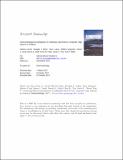Files in this item
Geomorphological investigation of multiphase glacitectonic composite ridge systems in Svalbard
Item metadata
| dc.contributor.author | Lovell, Harold | |
| dc.contributor.author | Benn, Douglas I. | |
| dc.contributor.author | Lukas, Sven | |
| dc.contributor.author | Spagnolo, Matteo | |
| dc.contributor.author | Cook, Simon J. | |
| dc.contributor.author | Swift, Darrel A. | |
| dc.contributor.author | Clark, Chris D. | |
| dc.contributor.author | Yde, Jacob C. | |
| dc.contributor.author | Watts, Tom P. | |
| dc.date.accessioned | 2018-10-31T00:48:38Z | |
| dc.date.available | 2018-10-31T00:48:38Z | |
| dc.date.issued | 2018-01-01 | |
| dc.identifier | 251464534 | |
| dc.identifier | 554a77b6-22e8-4118-be85-91808d97923e | |
| dc.identifier | 85033561227 | |
| dc.identifier | 000418981700013 | |
| dc.identifier.citation | Lovell , H , Benn , D I , Lukas , S , Spagnolo , M , Cook , S J , Swift , D A , Clark , C D , Yde , J C & Watts , T P 2018 , ' Geomorphological investigation of multiphase glacitectonic composite ridge systems in Svalbard ' , Geomorphology , vol. 300 , pp. 176-188 . https://doi.org/10.1016/j.geomorph.2017.10.024 | en |
| dc.identifier.issn | 0169-555X | |
| dc.identifier.other | RIS: urn:57120CA605DC764B31FDB955F0AFDB0F | |
| dc.identifier.other | ORCID: /0000-0002-3604-0886/work/64697382 | |
| dc.identifier.uri | https://hdl.handle.net/10023/16357 | |
| dc.description | HL was funded by a NERC PhD studentship (NE/I528050/1) at Queen Mary University of London, the Queen Mary Postgraduate Research Fund, and an Arctic Field Grant from the Research Council of Norway through the University Centre in Svalbard (UNIS). SL acknowledges funding from the Westfield Trust. JCY was funded by a Carlsberg Foundation grant (2007/01/0383). A Royal Geographical Society Peter Fleming Award and a grant from the National Geographic Committee for Research and Exploration to Andy Hodson helped fund some of the fieldwork. | en |
| dc.description.abstract | Some surge-type glaciers on the High-Arctic archipelago of Svalbard have large glacitectonic composite ridge systems at their terrestrial margins. These have formed by rapid glacier advance into proglacial sediments during the active surge phase, creating multicrested moraine complexes. Such complexes can be formed during single surge advances or multiple surges to successively less-extensive positions. The few existing studies of composite ridge systems have relied on detailed information on internal structure and sedimentology to reconstruct their formation and links to surge processes. However, natural exposures of internal structure are commonly unavailable, and the creation of artificial exposures is often problematic in fragile Arctic environments. To compensate for these issues, we investigate the potential for reconstructing composite ridge system formation based on geomorphological evidence alone, focusing on clear morphostratigraphic relationships between ridges within the moraine complex and relict meltwater channels/outwash fans. Based on mapping at the margins of Finsterwalderbreen (in Van Keulenfjorden) and Grønfjordbreen (in Grønfjorden), we show that relict meltwater channels that breach outer parts of the composite ridge systems are in most cases truncated upstream within the ridge complex by an inner pushed ridge or ridges at their ice-proximal extents. Our interpretation of this relationship is that the entire composite ridge system is unlikely to have formed during the same glacier advance but is instead the product of multiple advances to successively less-extensive positions, whereby younger ridges are emplaced on the ice-proximal side of older ridges. This indicates that the Finsterwalderbreen composite ridge system has been formed by multiple separate advances, consistent with the cyclicity of surges. Being able to identify the frequency and magnitude of former surges is important as it provides insight into the past behaviour of surge-type glaciers and, if absolute dating is possible, allows for the assessment of surge-type glacier response to climate change on decadal to centennial timescales. Although further investigations into the internal structure of these deposits should be sought where possible, our study demonstrates that geomorphology could be an invaluable tool for reconstructing the formation of composite ridge systems. | |
| dc.format.extent | 13 | |
| dc.format.extent | 2059135 | |
| dc.language.iso | eng | |
| dc.relation.ispartof | Geomorphology | en |
| dc.subject | Glacitectonic composite ridge system | en |
| dc.subject | Glacier surge | en |
| dc.subject | Glacial geomorphology | en |
| dc.subject | Svalbard | en |
| dc.subject | G Geography (General) | en |
| dc.subject | GE Environmental Sciences | en |
| dc.subject | NDAS | en |
| dc.subject.lcc | G1 | en |
| dc.subject.lcc | GE | en |
| dc.title | Geomorphological investigation of multiphase glacitectonic composite ridge systems in Svalbard | en |
| dc.type | Journal article | en |
| dc.contributor.institution | University of St Andrews. School of Geography & Sustainable Development | en |
| dc.contributor.institution | University of St Andrews. Bell-Edwards Geographic Data Institute | en |
| dc.identifier.doi | 10.1016/j.geomorph.2017.10.024 | |
| dc.description.status | Peer reviewed | en |
| dc.date.embargoedUntil | 2018-10-31 |
This item appears in the following Collection(s)
Items in the St Andrews Research Repository are protected by copyright, with all rights reserved, unless otherwise indicated.

